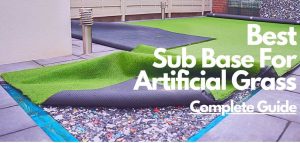Artificial grass is a great way to keep your yard looking good all year long. Many homeowners have a question when considering artificial grass is whether or not it will need a sub-base.
The sub base for artificial grass is a crucial component to the success and longevity of an installation. Without it, you risk having your fake lawn deteriorate in as little as five years due to weathering or damage from foot traffic.
Artificial Grass Sub Base ensures that your lawn stays lush and green with an even surface for any turf.
Contents
Benefits of having a Good Quality Artificial Grass Sub Base
Here are few advantages of installing a good quality sub-base for artificial grass.
- It provides a layer of protection to the artificial grass that creates an added aesthetic appeal to it.
- A sub base also ensures that the fibers are safe for use and no punctures occur on the surface by creating a protective barrier between it and other surfaces below it.
- It adds longevity to your artificial grass by protecting its primary components, which helps keep them looking at their best condition for more years than without one.
- A sub base gives a bouncier, softer feel underfoot, which is excellent for athletes who can afford to train on this kind of surface and children who play daily on surfaces like this in schools, clubhouses, playgrounds, etc.
- It adds a layer of protection from weed infestation, which helps to keep your lawn looking pristine and free from undesirable weeds growing on it.
- A sub base helps lower the noise levels coming from the surface by creating a buffer between it and other hard surfaces making up the playing or training area. This is especially beneficial for those living in areas where people sit on balconies above playing fields etc. Having a quieter environment will help them relax after hours of work during the day.
- A sub-base provides better drainage and filtration that prevents water from accumulating inside it, thus reducing or eliminating puddles that can occur during rainfall or watering periods as artificial grass drains very quickly.
TYPES OF ARTIFICIAL GRASS SUB-BASE
Numerous types of sub-base can be used when installing artificial grass, but the three main types are mostly preferred by installers and manufacturers worldwide.
1. CMB (Crushed Miscellaneous Base)
CMB is the cheapest and most used sub-base for artificial grass. However, it has a couple of downsides as well.
Since this type of base is not regulated, it contains many different types of rock that vary in size, from small pebbles to larger stones.
This can result in significant gaps within the base, leading to pockets forming, allowing water to accumulate, and possibly causing shifting issues where the grass meets another surface, such as a border or driveway.
While they offer a cost-effective way to install an artificial grass lawn, care must be taken when filling these voids, so proper grading is achieved.
2. Class II Road Base
Class II road base offers several advantages over the crushed miscellaneous base.
It is compacted to create a well-graded sub-base that allows proper drainage and stabilizes the sub-grade surface for your lawn to be installed on top.
The sub-base also provides good insulation, preventing hot spots that can lead to premature wear or burns since there are no rocks.
The expense of using this type of sub-base will vary depending on what area you live in.
However, it generally costs more than crushed miscellaneous base but less than decomposed granite.
3. Decomposed Granite
DG (Decomposed Granite) offers many benefits over CMB and Class II road base, including heat resistance, lower maintenance requirements, stability, durability, etc.
Although more expensive than CMB, it typically comes out cheaper than Class II road base when all factors are considered.
It is a cost-effective solution for artificial grass installations, ensuring your lawn won’t burn and have a longer lifespan.
How much Sub-Base is Required?
To determine how much CMB, DG, or Class II road base you require, take into consideration the following factors:
Size of border/edging Width
- Measure from the inside of the edging board, adding 10cm width to account for space taken up by edging boards Diameter .
- Measure from the center point of the circle you need to fill Square footage
- Multiply length x width Area in square meters – multiply area by 10 to get cubic meters Location
Surface with high traffic or play should be laid on a minimum 200mm depth of sub-base, while areas with less traffic could be laid on 150mm.
Areas to be installed under trees or shaded by other plants should have a thickness of 200mm as the grass will not receive enough light to bind correctly. Areas that are mostly shaded should have a minimum depth of 100mm.
Conclusion
Choosing a sub-base for your new artificial grass is one of the most important decisions you’ll make during installation.
The type of material, depth, and slope can have a profound impact on how long your project will last, in addition to other factors like weed control and water drainage.
There are many types of sub-base options available for your project; it’s worth doing some research before you decide what type to use to get the best possible results.
If you want help making this decision or need more information about what options are available to you, please write in the comment section; we will surely make your selection far more straightforward.
Also Read
